Debris Flow Susceptibility Assessment in the Wudongde Dam Area, China Based on Rock Engineering System and Fuzzy C-Means Algorithm
Abstract
:1. Introduction
2. Study Area
2.1. Geological and Tectonic Setting
2.2. Geomorphological Setting
2.3. Meteorological Setting
3. Influencing Parameters
3.1. Lithology
3.2. Watershed Area
3.3. Slope Angle
3.4. Stream Density
3.5. Length of the Main Stream
3.6. Curvature of the Main Stream
3.7. Distance from Fault
3.8. Vegetation Cover Ratio
4. Method
4.1. Rock Engineering System
4.2. Fuzzy C-Means Algorithm
5. Results and Discussion
5.1. RES Model for Debris Flow Susceptibility Assessment
5.2. Debris Flow Susceptibility Assessment
5.3. Validation of the Model
6. Conclusions
Acknowledgments
Author Contributions
Conflicts of Interest
References
- Rickenmann, D. Empirical relationships for debris flows. Nat. Hazards 1999, 19, 47–77. [Google Scholar] [CrossRef]
- Conway, S.J.; Decaulne, A.; Balme, M.R.; Murray, J.B.; Towner, M.C. A new approach to estimating hazard posed by debris flows in the Westfjords of Iceland. Geomorphology 2010, 114, 556–572. [Google Scholar] [CrossRef]
- Kanji, M.A.; Cruz, P.T.; Massad, F. Debris flow affecting the Cubatão oil refinery, Brazil. Landslides 2008, 5, 71–82. [Google Scholar] [CrossRef]
- Kappes, M.S.; Malet, J.P.; Remaître, A.; Horton, P.; Jaboyedoff, M.; Bell, R. Assessment of debris-flow susceptibility at medium-scale in the Barcelonnette Basin, France. Nat. Hazards Earth Syst. Sci. 2011, 11, 627–641. [Google Scholar] [CrossRef]
- Horton, P.; Jaboyedoff, M.; Rudaz, B.; Zimmermann, M. Flow-R, a model for susceptibility mapping of debris flows and other gravitational hazards at a regional scale. Nat. Hazards Earth Syst. Sci. 2013, 13, 869–885. [Google Scholar] [CrossRef] [Green Version]
- Chang, T.C.; Chien, Y.H. The application of genetic algorithm in debris flow prediction. Environ. Geol. 2007, 53, 339–347. [Google Scholar] [CrossRef]
- Chang, T.C.; Chao, R.J. Application of back-propagation networks in debris flow prediction. Eng. Geol. 2006, 85, 270–280. [Google Scholar] [CrossRef]
- Chang, T.C. Risk degree of debris flow applying neural networks. Nat. Hazards 2007, 42, 209–224. [Google Scholar] [CrossRef]
- Conforti, M.; Pascale, S.; Robustelli, G.; Sdao, F. Evaluation of prediction capability of the artificial neural networks for mapping landslide susceptibility in the Turbolo River catchment (northern Calabria, Italy). Catena 2014, 113, 236–250. [Google Scholar] [CrossRef]
- Liu, C.N.; Dong, J.J.; Peng, Y.F.; Huang, H.F. Effects of strong ground motion on the susceptibility of gully type debris flows. Eng. Geol. 2009, 104, 241–253. [Google Scholar] [CrossRef]
- Wan, S.; Lei, T.C. A knowledge-based decision support system to analyze the debris-flow problems at Chen-Yu-Lan River, Taiwan. Knowl.-Based Syst. 2009, 22, 580–588. [Google Scholar] [CrossRef]
- Dai, F.C.; Lee, C.F.; Tham, L.G.; Ng, K.C.; Shun, W.L. Logistic regression modelling of storm-induced shallow landsliding in time and space on natural terrain of Lantau Island, Hong Kong. Bull. Eng. Geol. Environ. 2004, 63, 315–327. [Google Scholar] [CrossRef]
- Ayalew, L.; Yamagishi, H. The application of GIS-based logistic regression for landslide susceptibility mapping in the Kakuda-Yahiko Mountains, central Japan. Geomorphology 2005, 65, 15–31. [Google Scholar] [CrossRef]
- Greco, R.; Sorriso-Valvo, M.; Catalano, E. Logistic regression analysis in the evaluation of mass movements susceptibility: The Aspromonte case study, Calabria, Italy. Eng. Geol. 2007, 89, 47–66. [Google Scholar] [CrossRef]
- Manzo, G.; Tofani, V.; Segoni, S.; Battistini, A.; Catani, F. GIS techniques for regional-scale landslide susceptibility assessment: The Sicily (Italy) case study. Int. J. Geogr. Inf. Sci. 2013, 27, 1433–1452. [Google Scholar] [CrossRef]
- Dong, J.J.; Lee, C.T.; Tung, Y.H.; Liu, C.N.; Lin, K.P.; Lee, J.F. The role of the sediment budget in understanding debris flow susceptibility. Earth Surf. Proc. Landf. 2009, 34, 1612–1624. [Google Scholar] [CrossRef]
- Bertrand, M.; Liébault, F.; Piégay, H. Debris-flow susceptibility of upland catchments. Nat. Hazards 2013, 67, 497–511. [Google Scholar] [CrossRef]
- Song, Y.Q.; Gong, J.H.; Gao, S.; Wang, D.C.; Cui, T.J.; Li, Y.; Wei, B.Q. Susceptibility assessment of earthquake-induced landslides using Bayesian network: A case study in Beichuan, China. Comput. Geosci. 2012, 42, 189–199. [Google Scholar] [CrossRef]
- Ahmed, B.; Dewan, A. Application of bivariate and multivariate statistical techniques in landslide susceptibility modeling in Chittagong city corporation, Bangladesh. Remote Sens. 2017, 42, 304. [Google Scholar] [CrossRef]
- Baeza, C.; Corominas, J. Assessment of shallow landslide susceptibility by means of multivariate statistical techniques. Earth Surf. Proc. Landf. 2001, 26, 1251–1263. [Google Scholar] [CrossRef]
- Guzzetti, F.; Reichenbach, P.; Ardizzone, F.; Cardinali, M.; Galli, M. Estimating the quality of landslide susceptibility models. Geomorphology 2006, 81, 166–184. [Google Scholar] [CrossRef]
- Xu, W.; Jing, S.; Yu, W.; Wang, Z.; Zhang, G.; Huang, J. A comparison between Bayes discriminant analysis and logistic regression for prediction of debris flow in southwest Sichuan, China. Geomorphology 2013, 201, 45–51. [Google Scholar] [CrossRef]
- Kayastha, P.; Dhital, M.R.; De Smedt, F. Application of the analytical hierarchy process (AHP) for landslide susceptibility mapping: A case study from the Tinau watershed, west Nepal. Comput. Geosci. 2013, 52, 398–408. [Google Scholar] [CrossRef]
- Meyer, N.K.; Schwanghart, W.; Korup, O.; Romstad, B.; Etzelmüller, B. Estimating the topographic predictability of debris flows. Geomorphology 2014, 207, 114–125. [Google Scholar] [CrossRef]
- Yalcin, A. GIS-based landslide susceptibility mapping using analytical hierarchy process and bivariate statistics in Ardesen (Turkey): Comparisons of results and confirmations. Catena 2008, 72, 1–12. [Google Scholar] [CrossRef]
- Yalcin, A.; Reis, S.; Aydinoglu, A.C.; Yomralioglu, T. A GIS-based comparative study of frequency ratio, analytical hierarchy process, bivariate statistics and logistics regression methods for landslide susceptibility mapping in Trabzon, NE Turkey. Catena 2011, 85, 274–287. [Google Scholar] [CrossRef]
- Pradhan, B. Landslide susceptibility mapping of a catchment area using frequency ratio, fuzzy logic and multivariate logistic regression approaches. J. Indian Soc. Remote 2010, 38, 301–320. [Google Scholar] [CrossRef]
- Hudson, J.A. Rock Engineering Systems: Theory and Practice; Ellis Horwood Ltd.: Chichester, UK, 1992; pp. 154–185. [Google Scholar]
- Bezdek, J.C. Pattern Recognition with Fuzzy Objective Function Algorithms; Plenum Press: New York, NY, USA, 1981; pp. 203–239. [Google Scholar]
- Li, Y.Y.; Chen, J.P.; Shang, Y.J. An RVM-based model for assessing the failure probability of slopes along the Jinsha River, close to the Wudongde dam site, China. Sustainability 2017, 9, 32. [Google Scholar] [CrossRef]
- Niu, C. Index Selection and Rating for Debris Flow Hazard Assessment. Ph.D. Thesis, Jilin University, Changchun, China, 2013; p. 143. [Google Scholar]
- Chen, H.; Hu, J.M.; Qu, H.J.; Wu, G.L. Early Mesozoic structural deformation in the Chuandian N-S Tectonic Belt, China. Sci. China Ser. D 2011, 54, 1651–1664. [Google Scholar] [CrossRef]
- Zhang, W.; Chen, J.P.; Wang, Q.; An, Y.; Qian, X.; Xiang, L.; He, L. Susceptibility analysis of large-scale debris flows based on combination weighting and extension methods. Nat. Hazards 2013, 66, 1073–1100. [Google Scholar] [CrossRef]
- Zhang, W.; Li, H.Z.; Chen, J.P.; Zhang, C.; Xu, L.M.; Sang, W.F. Comprehensive hazard assessment and protection of debris flows along Jinsha River close to the Wudongde dam site in China. Nat. Hazards 2011, 58, 459–477. [Google Scholar] [CrossRef]
- Hu, W.; Xu, Q.; Rui, C.; Huang, R.Q.; van Asch, T.W.J.; Zhu, X.; Xu, Q.Q. An instrumented flume to investigate the initiation mechanism of the post-earthquake huge debris flow in the southwest of China. Bull. Eng. Geol. Environ. 2015, 74, 393–404. [Google Scholar] [CrossRef]
- Lin, P.S.; Lin, J.Y.; Hung, J.C.; Yang, M.D. Assessing debris-flow hazard in a watershed in Taiwan. Eng. Geol. 2002, 66, 295–313. [Google Scholar] [CrossRef]
- Rickenmann, D.; Zimmermann, M. The 1987 debris flows in Switzerland: Documentation and analysis. Geomorphology 1993, 8, 175–189. [Google Scholar] [CrossRef]
- Lei, T.C.; Wan, S.; Chou, T.Y.; Pai, H.C. The knowledge expression on debris flow potential analysis through PCA + LDA and rough sets theory: A case study of Chen-Yu-Lan watershed, Nantou, Taiwan. Environ. Earth Sci. 2011, 63, 981–997. [Google Scholar] [CrossRef]
- Mousavi, S.M.; Omidvar, B.; Ghazban, F.; Feyzi, R. Quantitative risk analysis for earthquake-induced landslides—Emamzadeh Ali, Iran. Eng. Geol. 2011, 122, 191–203. [Google Scholar] [CrossRef]
- Hudson, J.A.; Harrison, J.P. A new approach to studying complete rock engineering problems. Q. J. Eng. Geol. Hydrogeol. 1992, 25, 93–105. [Google Scholar] [CrossRef]
- Huang, R.; Huang, J.; Ju, N.; Li, Y. Automated tunnel rock classification using rock engineering systems. Eng. Geol. 2013, 156, 20–27. [Google Scholar] [CrossRef]
- Faramarzi, F.; Mansouri, H.; Ebrahimi Farsangi, M.A. A rock engineering systems based model to predict rock fragmentation by blasting. Int. J. Rock Mech. Min. Sci. 2013, 60, 82–94. [Google Scholar] [CrossRef]
- Jiao, Y.; Hudson, J.A. The fully-coupled model for rock engineering systems. Int. J. Rock Mech. Min. Sci. 1995, 32, 491–512. [Google Scholar] [CrossRef]
- Zhang, B.; Qin, S.; Wang, W.; Wang, D.; Xue, L. Data stream clustering based on Fuzzy C-Mean algorithm and entropy theory. Signal Process. 2016, 126, 111–116. [Google Scholar] [CrossRef]
- Hammah, R.E.; Curran, J.H. Fuzzy cluster algorithm for the automatic identification of joint sets. Int. J. Rock Mech. Min. Sci. 1998, 35, 889–905. [Google Scholar] [CrossRef]
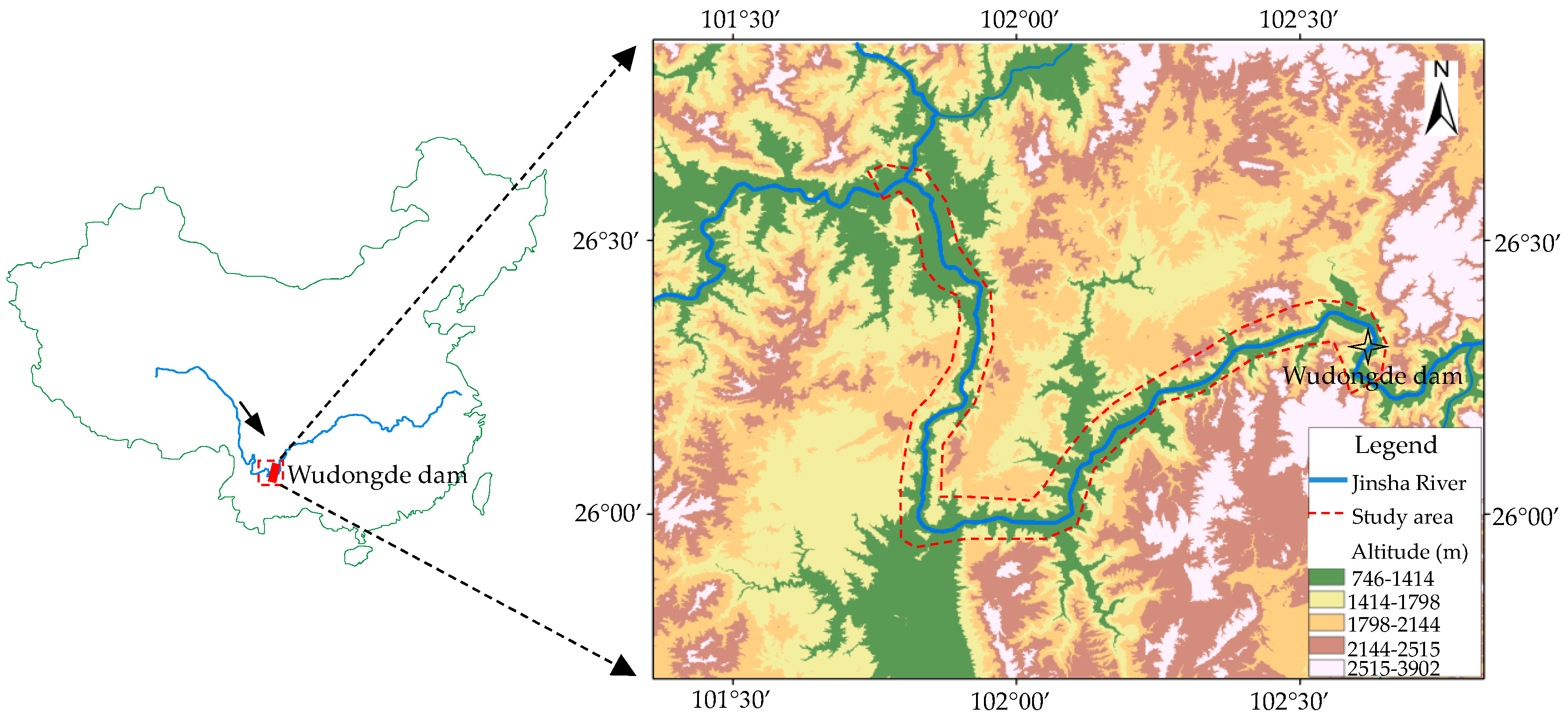

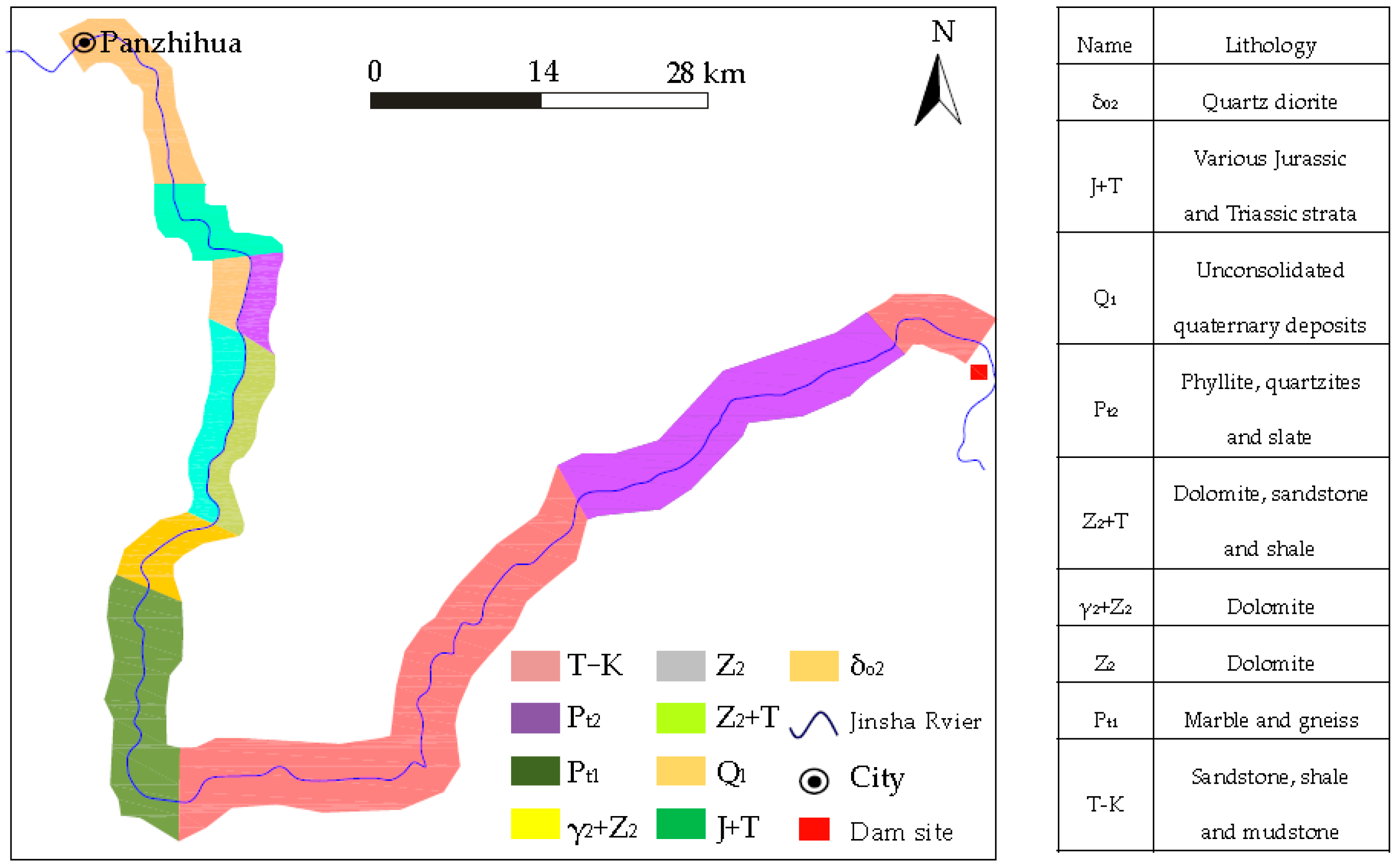
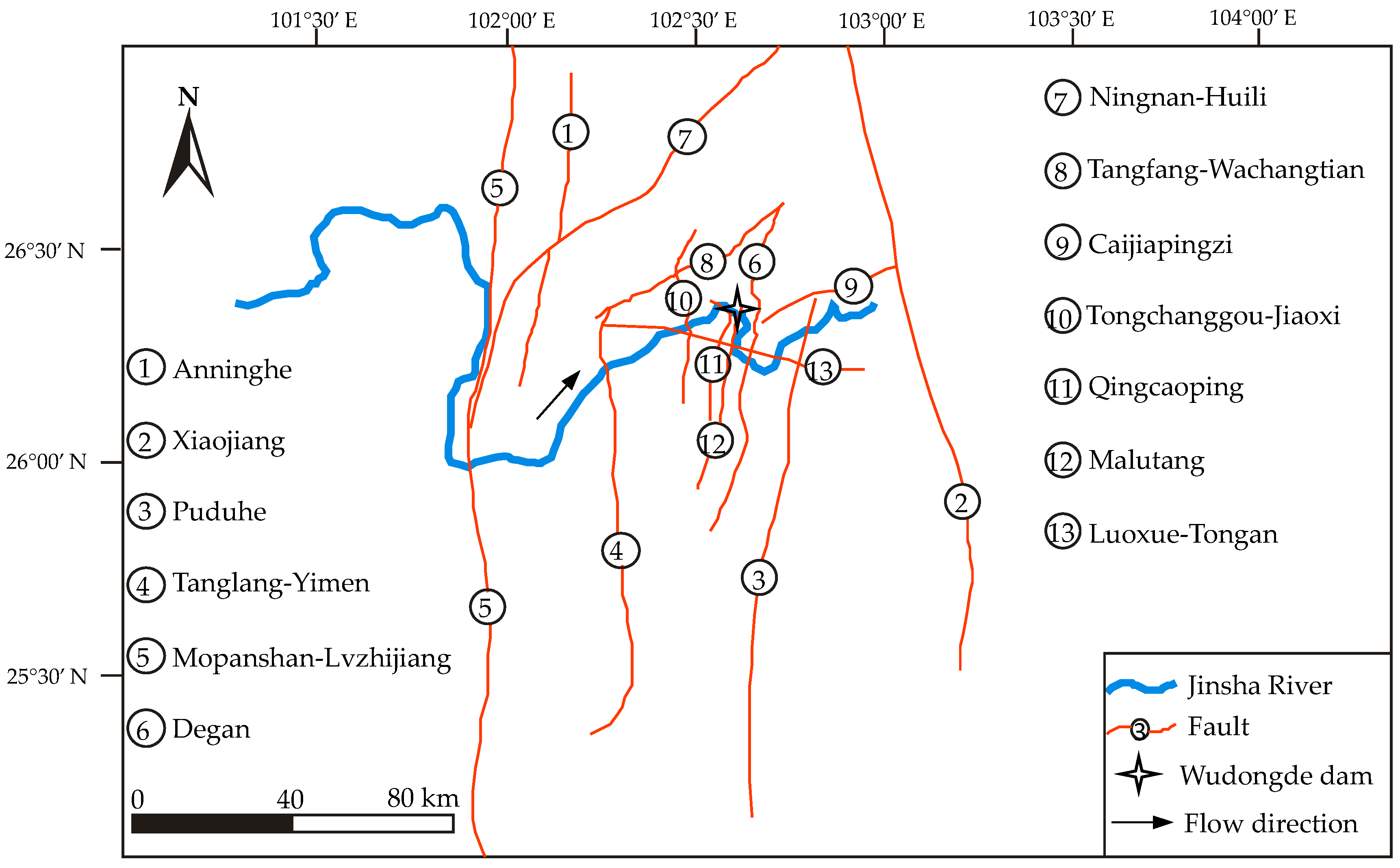
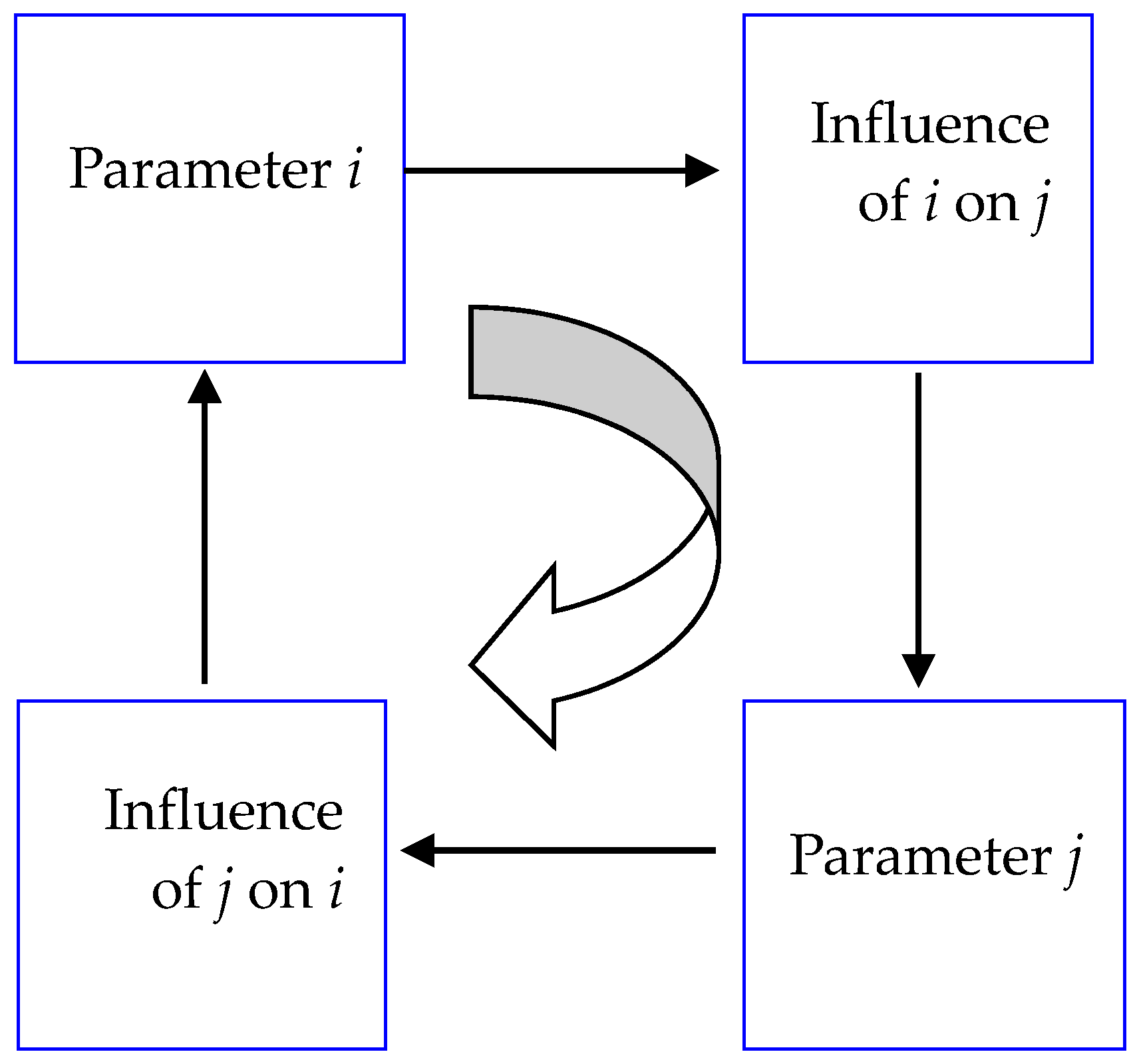
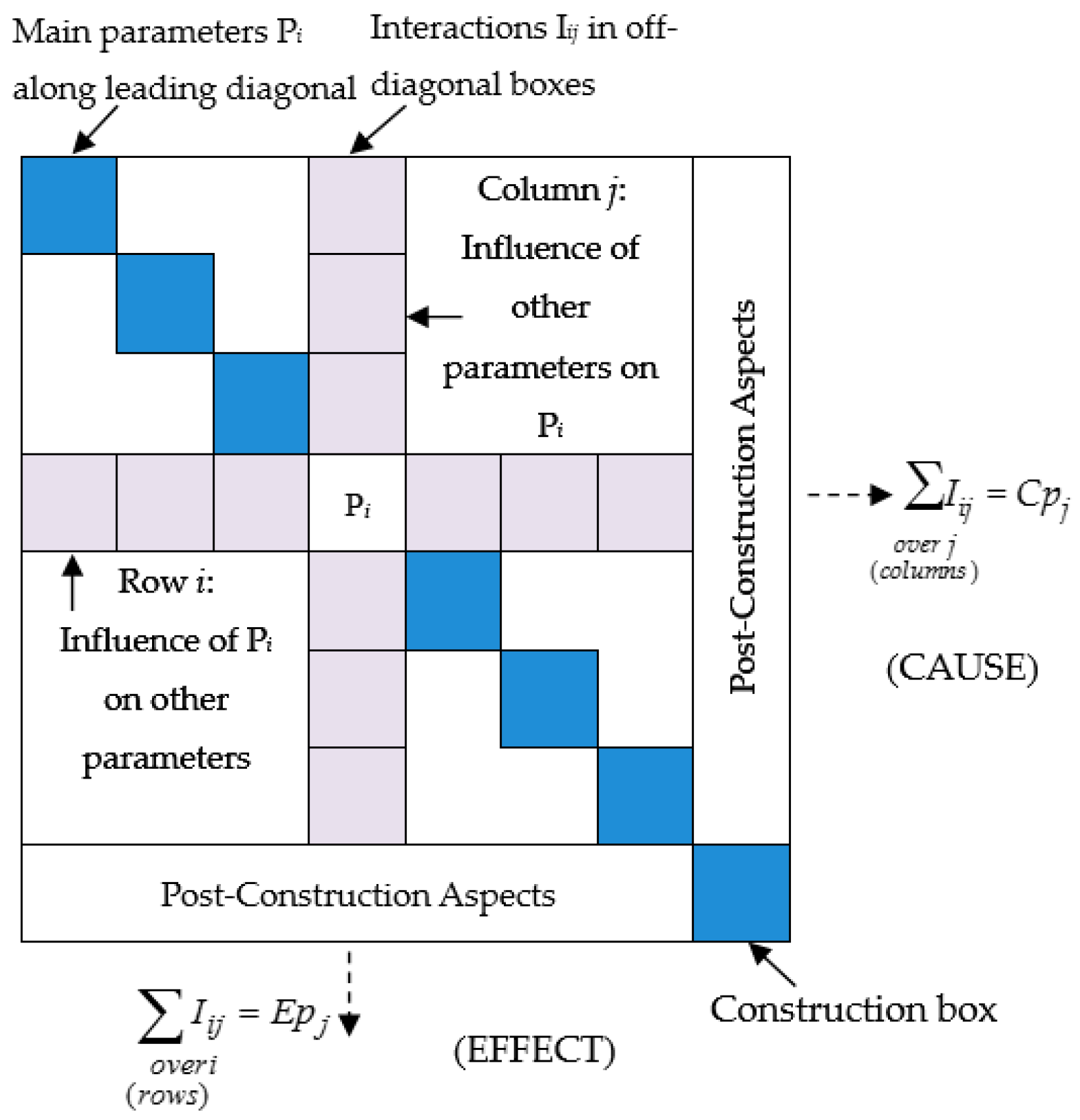
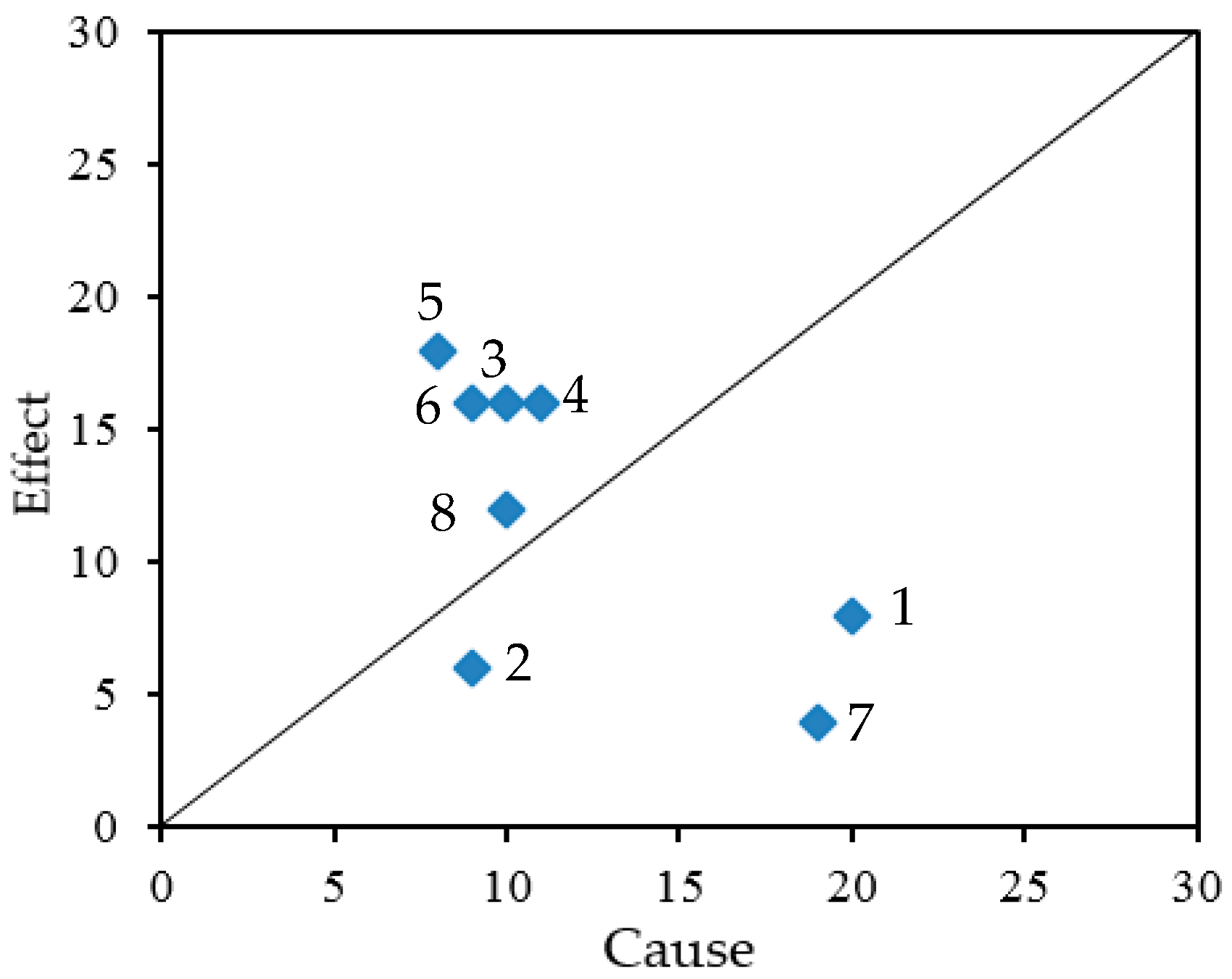
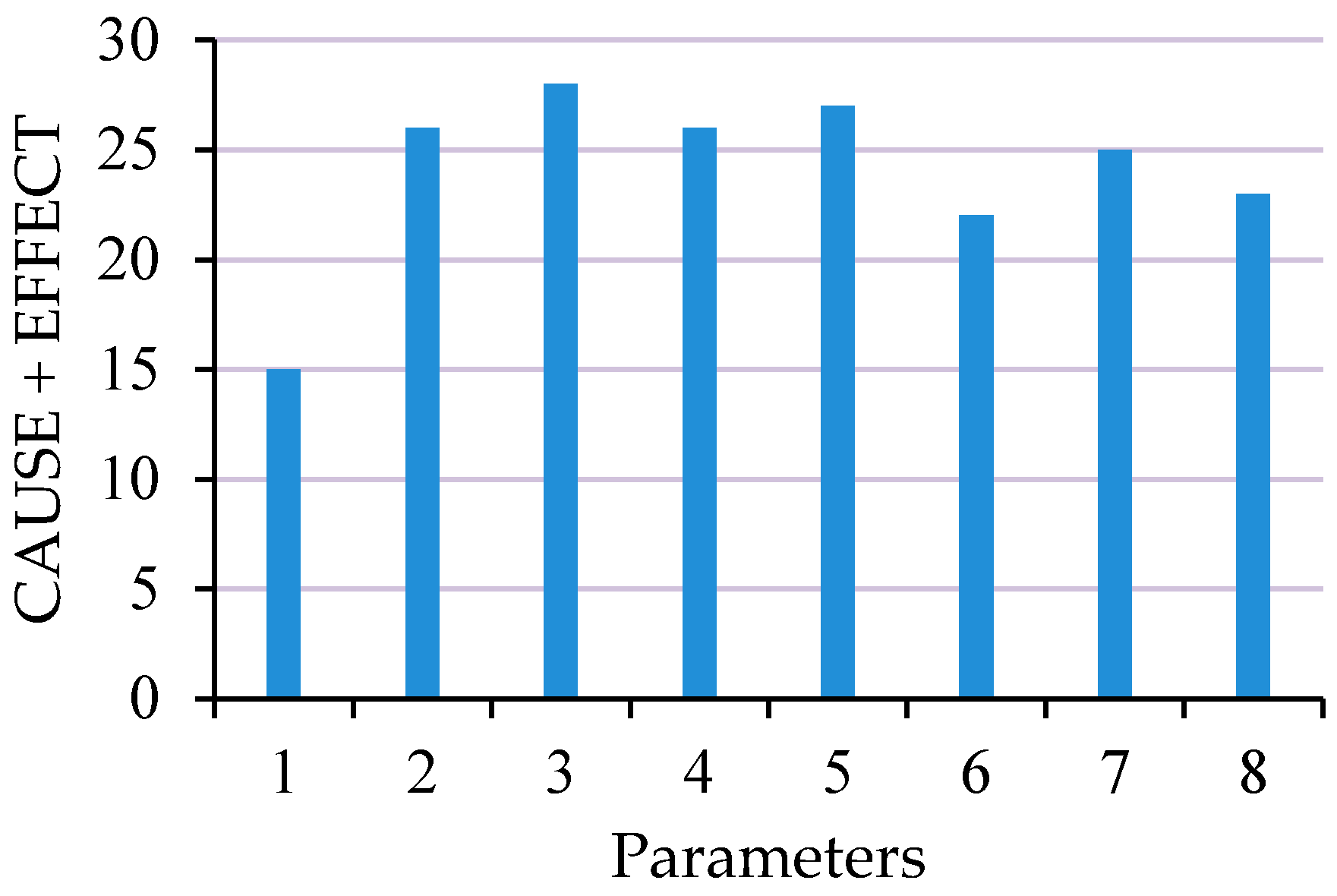
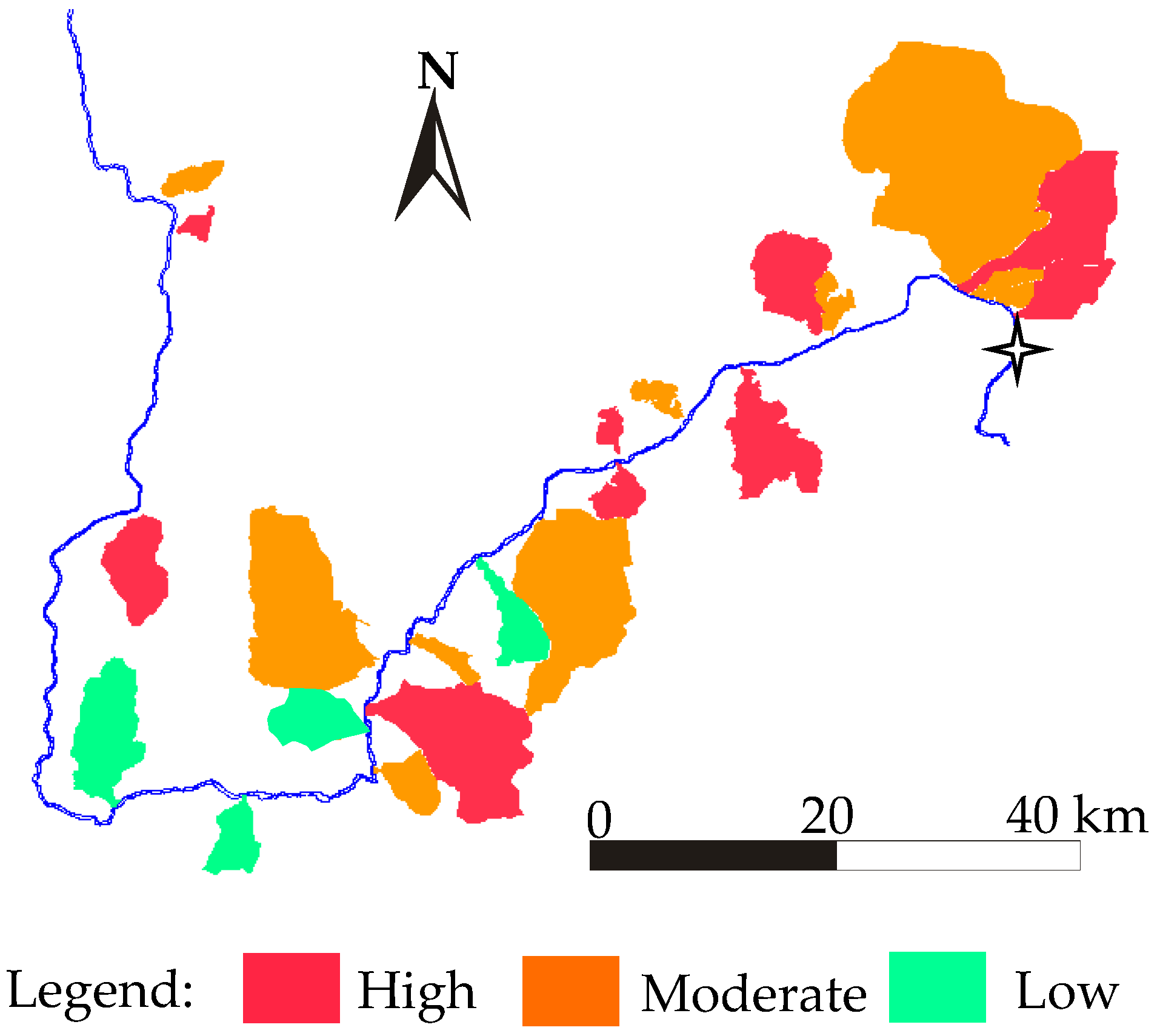
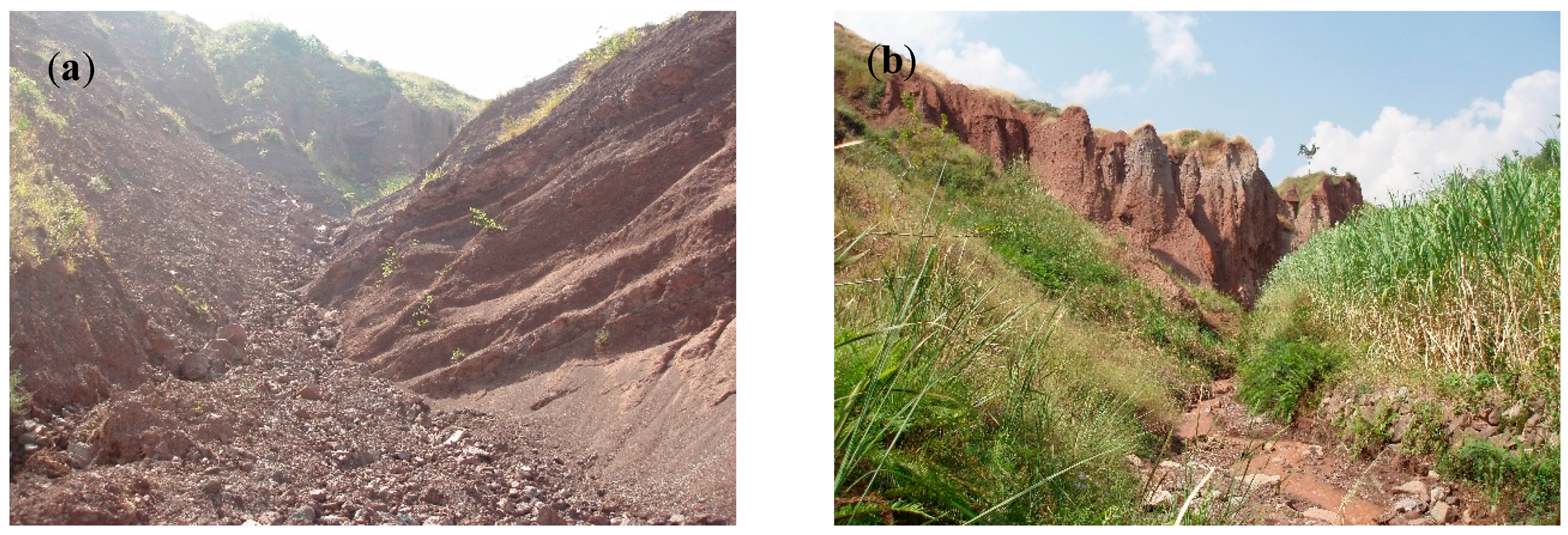

| Description | Rating | Description | Rating |
|---|---|---|---|
| 1. Lithology | 5. Length of the main stream (km) | ||
| Magmatic rocks, and limestones | 0 | <1 | 0 |
| Phyllite, slate and schist | 1 | 1–5 | 1 |
| Sandstones, mudstones, and shale | 2 | 5–10 | 2 |
| Quaternary deposits | 3 | >10 | 3 |
| 2. Watershed area (km2) | 6. Curvature of the main stream | ||
| <0.5 or >50 | 0 | <1.1 | 0 |
| 0.5–10 | 1 | 1.1–1.25 | 1 |
| 10–35 | 2 | 1.25–1.4 | 2 |
| 35–50 | 3 | >1.4 | 3 |
| 3. Slope angle (°) | 7. Distance from fault (km) | ||
| <15 | 0 | >0.6 | 0 |
| 15–25 | 1 | 0.4–0.6 | 1 |
| 25–32 | 2 | 0.2–0.4 | 2 |
| >32 | 3 | <0.2 | 3 |
| 4. Stream density (km/km2) | 8. Vegetation cover ratio | ||
| <5 | 0 | >0.75 | 0 |
| 5–10 | 1 | 0.5–0.75 | 1 |
| 10–20 | 2 | 0.25–0.5 | 2 |
| >20 | 3 | <0.25 | 3 |
| Coding | Description |
|---|---|
| 0 | No interaction |
| 1 | Weak interaction |
| 2 | Medium interaction |
| 3 | Strong interaction |
| 4 | Critical interaction |
| P1 | 2 | 4 | 3 | 3 | 3 | 2 | 3 |
|---|---|---|---|---|---|---|---|
| 0 | P2 | 2 | 1 | 2 | 1 | 2 | 1 |
| 0 | 1 | P3 | 2 | 3 | 2 | 0 | 2 |
| 1 | 0 | 3 | P4 | 2 | 3 | 0 | 2 |
| 1 | 0 | 2 | 2 | P5 | 2 | 0 | 1 |
| 1 | 0 | 1 | 2 | 4 | P6 | 0 | 1 |
| 3 | 3 | 3 | 3 | 2 | 3 | P7 | 2 |
| 2 | 0 | 1 | 3 | 2 | 2 | 0 | P8 |
| Parameter | Ci | Ei | wi (%) |
|---|---|---|---|
| Lithology | 20 | 8 | 14.58 |
| Watershed area | 9 | 6 | 7.81 |
| Slope angle | 10 | 16 | 13.54 |
| Stream density | 11 | 16 | 14.06 |
| Length of the main stream | 8 | 18 | 13.54 |
| Curvature of the main stream | 9 | 16 | 13.02 |
| Distance from fault | 19 | 4 | 11.98 |
| Vegetation cover | 10 | 12 | 11.46 |
| Gullies | Influencing Parameters | SI | RES_KM | RES_FCM | Actual Condition | |||||||
|---|---|---|---|---|---|---|---|---|---|---|---|---|
| P1 | P2 | P3 | P4 | P5 | P6 | P7 | P8 | |||||
| Xiabaitan | T–K | 3.1 | 36.1 | 5.51 | 3.08 | 1.19 | 0 | 10 | 188.53 | High | High | High |
| Shangbaitan | T–K | 0.91 | 28.5 | 10.29 | 1.87 | 1.08 | 0 | 10 | 176.03 | Moderate | Moderate | Moderate |
| Menggugou | Pt2 | 37.1 | 41.37 | 6.73 | 10.52 | 1.13 | 0 | 40 | 205.19 | High | High | High |
| Aibagou | Pt2 | 6.66 | 42.13 | 8.43 | 5.09 | 1.19 | 0 | 20 | 187.49 | High | High | High |
| Nuozhacun | γ2 + Z2 | 32.61 | 40 | 4.96 | 10.5 | 1.17 | 0 | 10 | 194.78 | High | High | High |
| Zhugongdi | T–K | 6.5 | 41.8 | 6.24 | 4.98 | 1.15 | 0 | 15 | 176.55 | Moderate | Moderate | Moderate |
| Yindigou | T–K | 60.5 | 43.26 | 5.08 | 20.17 | 1.23 | 166 | 18 | 207.8 | High | High | Moderate |
| Fujiahe | Pt2 | 8.62 | 42.7 | 6.34 | 5.16 | 1.26 | 0 | 17 | 176.55 | Moderate | Moderate | Moderate |
| Zhangmuhe | Pt2 | 4.62 | 29.1 | 9.7 | 5.39 | 1.42 | 0 | 10 | 199.99 | High | High | Moderate |
| Hepiao | J + K | 9.1 | 29.6 | 9.9 | 6.83 | 1.32 | 0 | 30 | 175.51 | Moderate | Moderate | Moderate |
| Hongmenchang | Pt2 | 46.9 | 30 | 6.6 | 12.9 | 1.29 | 0 | 15 | 216.13 | High | High | High |
| Tianfanghe | Pt2 | 13.1 | 34 | 9.3 | 5.6 | 1.17 | 0 | 16 | 195.3 | High | High | High |
| Zhiligou | T–K | 120.6 | 24 | 6.3 | 15.8 | 1.28 | 0 | 25 | 181.76 | Moderate | Moderate | Moderate |
| Pingdicun | T–K | 24.2 | 17 | 5.9 | 9.9 | 1.14 | 3000 | 40 | 171.34 | Moderate | Moderate | Moderate |
| Fangshanguo | T–K | 98 | 28 | 4.63 | 20.2 | 1.38 | 6662 | 10 | 193.22 | High | High | High |
| Daqiangou | T–K | 18.9 | 29 | 10.95 | 5.1 | 1.11 | 18 | 17 | 174.46 | Moderate | Moderate | Moderate |
| Shenyuhe | T–K | 256 | 21 | 2.26 | 29.63 | 1.47 | 0 | 50 | 169.26 | Low | Moderate | Moderate |
| Zhuzhahe | T–K | 152.6 | 26.6 | 4.32 | 26.3 | 1.7 | 378 | 20 | 170.3 | Moderate | Moderate | Moderate |
| Heizhe | T–K | 51.7 | 13.5 | 5.12 | 13.9 | 1.15 | 3485 | 20 | 167.18 | Low | Low | Low |
| Yanshuijing | Pt1 | 48.58 | 22.6 | 9.25 | 14.43 | 1.22 | 0 | 5 | 153.63 | Low | Low | Low |
| Yajiede | T–K | 22.3 | 12 | 4.7 | 9.3 | 1.31 | 0 | 70 | 145.3 | Low | Low | Low |
| Daqinggou | T–K | 31.8 | 32 | 6.02 | 7.32 | 1.1 | 378 | 15 | 147.38 | Low | Low | Low |
| Level | Susceptibility Degree | Description |
|---|---|---|
| 1 | High | Abundance of loose materials accumulated on slopes, steep channels, inventory of debris flows |
| 2 | Moderate | Between levels 1 and 3 |
| 3 | Low | Absence of loose materials, smooth terrains , no debris flow record |
© 2017 by the authors. Licensee MDPI, Basel, Switzerland. This article is an open access article distributed under the terms and conditions of the Creative Commons Attribution (CC BY) license (http://creativecommons.org/licenses/by/4.0/).
Share and Cite
Li, Y.; Wang, H.; Chen, J.; Shang, Y. Debris Flow Susceptibility Assessment in the Wudongde Dam Area, China Based on Rock Engineering System and Fuzzy C-Means Algorithm. Water 2017, 9, 669. https://doi.org/10.3390/w9090669
Li Y, Wang H, Chen J, Shang Y. Debris Flow Susceptibility Assessment in the Wudongde Dam Area, China Based on Rock Engineering System and Fuzzy C-Means Algorithm. Water. 2017; 9(9):669. https://doi.org/10.3390/w9090669
Chicago/Turabian StyleLi, Yanyan, Honggang Wang, Jianping Chen, and Yanjun Shang. 2017. "Debris Flow Susceptibility Assessment in the Wudongde Dam Area, China Based on Rock Engineering System and Fuzzy C-Means Algorithm" Water 9, no. 9: 669. https://doi.org/10.3390/w9090669




